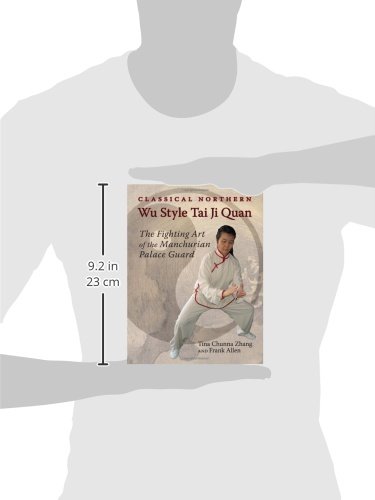


Classical Northern Wu Style Tai Ji Quan: The Fighting Art of the Manchurian Palace Guard
C**N
Interesting alternative to Yang.
This is a good book about a style which, apparently, developed from the Yang form. The sequence of moves is very similar so it is an interesting question as to how and why it differs. My own feeling I is that if you practice the Yang form for long enough, you might eventually end up with the Wu form.The book doesn't address the Yang style though, giving just a history of the Wu style and then a description of the moves. The Wu sword form is similarly described with photos. There are chapters on the theory and principles. I think it is a more intricate style to learn if you have just the book but, with online videos available, it is a useful resource to learn from.The weakest part, in my view, are the rather dubious looking applications. The resemble wrestling rather than anything distinctly taiji. I would have liked to have seen those pages devoted to a full description of Wu pushing hands. Also, it is not clear which if the authors writes which chapters.Overall, a good book about an interesting style.
A**S
Clear and well presented, but a different WU style to that which I am being taught.
This looks like a really good book on WU Style Taichi and is well presented. However, it is northern style WU and my tutor is from the Shanghai (Eddie WU) school and so there are differences. I was tempted to return it, but I liked the presentation so much, I hope to learn some things from it, even it my tutor will then correct what I am 'doing wrong' from his perspective.
D**M
Five Stars
Good background detail to Tai Chi, pictures/graphics very good.
M**S
Helpful Guide
Interesting & helpful for beginners & intermediates
A**E
good book
Good book, good presentation. Clear and concise. Will be used for a long time and added to my collection. Happy
R**G
Wu: North and South
It was great to get the perspective of people who had a direct lineage to the Northern Wu Style. I have seen other books by Chinese authors who practice this style, but the fact that they did not have a really strong connection to American authors made for difficult reading. What was particularly interesting was the account of how Tai Chi Chuan made it from the Chen village to the military academies of the North. This was always a bit of a puzzle among sifus who had only been taught the Southern Wu style. I had never seen a reference to the fact that there was a lot of marketing savvy mixed in with the mythology as Tai Chi Chuan became more popular in China. It made a lot of sense. This book fleshed out a lot of the history, and demystified a lot of puzzles that surround Wu style, and the broader picture of Tai Chi Chuan. This book really is a collector's item for anyone interested in Tai Chi Chuan; Wu style in particular.
W**G
Well worth the wait.
This is what I look for in a martial arts book. It is well-written, concise, and coherent. It is aesthetically pleasing but still very practical, much like the art it describes.The sections on the art's history, philosophy and applications are informative and colorful without being "hyped". The complete, illustrated Wu "long form" section is terrific, with notes on each movement; it will be invaluable for reference and review. The entire sword form is also illustrated and explained (although, unlike the "long form", combat applications of the sword movements are not included). The authors' close connection with Li Bing Ci makes this book a terrific companion to his excellent but erratically-subtitled DVD's; I feel like I finally have the "interpreter" I have often wished for while attempting to follow his demonstrations.This book will take its place next to my dog-eared "Aikido and the Dynamic Sphere" by Westbrook and Ratti, and a number of lesser Tai Chi books will now be bound for the next garage sale.
P**S
Interesting book
I am studying a similar Tai Chi Chuan style. I like seeing the differences in the various family styles. Enjoyed the history section.
R**M
General Info about Taichi
This is a general review on the art. I would recommend it to those with a little to no notion of Taichi. Those already initiate in the art would be better off searching a little more.As most books, the basic form is photographed which makes it very hard to follow.Other than that: Entertaining...
T**G
Excellent overview of Northern Wu-style Taijiquan
This is an excellent example of what a book about a martial art should be. It includes historical background, suggestions for learning and practice, and detailed descriptions and clear photographic breakdown of the forms. I wouldn't recommend anyone to try to learn any martial art from a book without a teacher, but this book makes an excellent supplement to the study of this branch of Wu-style taijiquan. It should also be part of the library of anyone collecting books on taijiquan.
Trustpilot
2 weeks ago
3 weeks ago